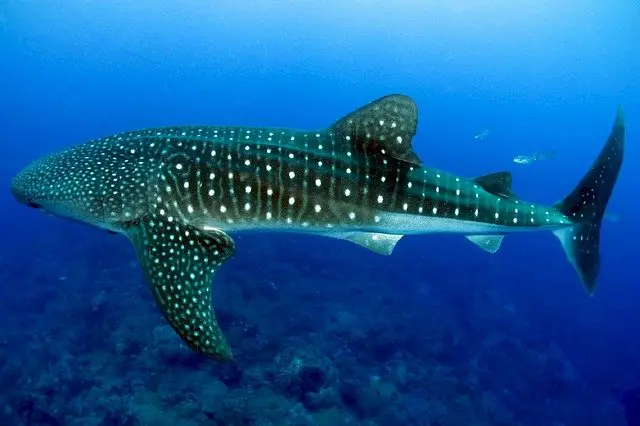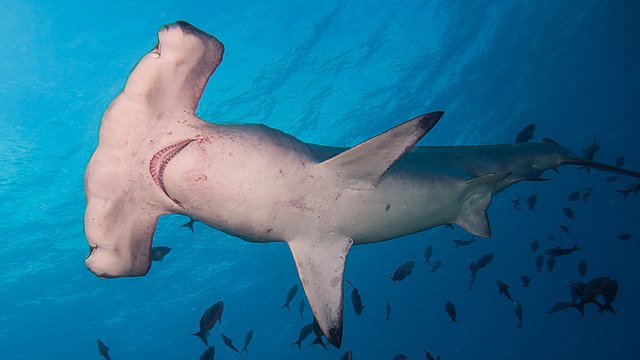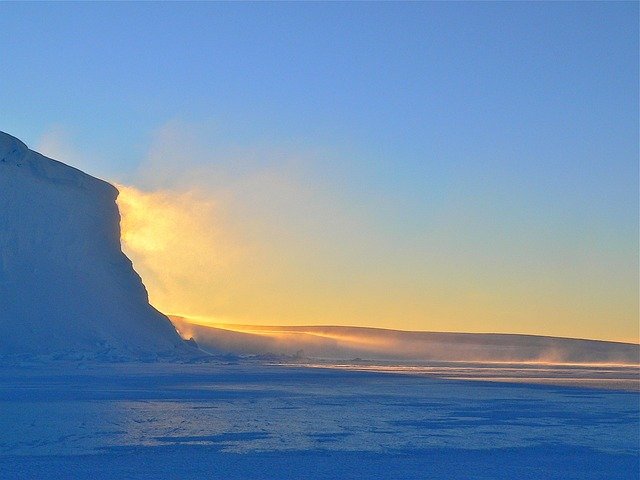The Great White Shark is the largest predator fish in the world known for its bite force of 18,216 newtons. It is found in the coastal areas of all the oceans in the world. We have gathered a complete set of Great White Shark Facts For Kids that will help kids in learning All About Great White Sharks. They are going to learn its scientific name, classification, appearance, size, weight, teeth, lifespan, speed, diet, prey, food chain, habitat, migration, lifecycle, reproduction, babies, shark attacks, behavior, adaptations, population, endangerment, predators and Great White Shark interesting facts.
Great White Shark Facts For Kids
What Is A Great White Shark
- The great white shark is a species of large mackerel shark and is the largest known living predatory fish in the world.
- It is also known as the white shark, great white, or white pointer.
- It is also one of the known longest living cartilaginous fish with an estimated lifespan of 70 years or more.
- The great white shark is known for its huge size and grows to a maximum size of 6.1 meters while weighing from 1,905 to 2,268 kg.
- Like other sharks, it is a carnivore and eats fish, cetaceans, seals, sea turtles, seabirds, etc.
- Great white sharks have a large natural range and are found in coastal waters of all major oceans.
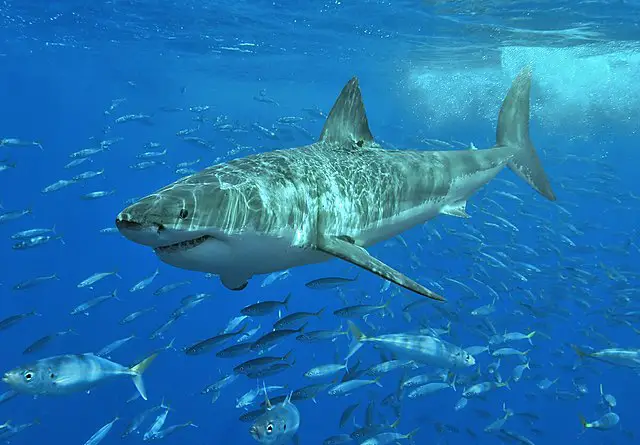
Great White Shark Scientific Name
- The scientific name of the great white shark is Carcharodon carcharias.
Great White Shark Taxonomy
- The following is the scientific classification or taxonomy of great white shark:
| Kingdom | Animalia |
| Phylum | Chordata |
| Subphylum | Vertebrata |
| Class | Chondrichthyes |
| Order | Lamniformes |
| Family | Lamnidae |
| Genus | Carcharodon |
| Species | Carcharodon carcharias |
Are White Sharks Warm Blooded
- Warm-blooded are the animal species that can maintain their body temperature constant regardless of the environmental temperature.
- Unlike most shark species (which are cold-blooded), great white sharks are partially warm-blooded.
- They can raise the temperature of some of their body parts by +/- 10 to 15℃ than the outside temperature through a unique system known as Countercurrent Heat Exchange.
- So in 9℃ warm water, the body temperature of a white shark will be +/- 19 to 24℃.
- The long muscles that run down through the length of a white shark’s body generate this heat and transfer it to the web of veins and arteries at the lateral sides of their bodies.
What Do Great White Sharks Look Like – Great White Sharks Description
- Great white sharks have an average body length of 15 feet, while some specimens grow to up to 20 feet.
- They have an average body weight of 522 to 771 kg.
- A great white shark has a long, conical, and sturdy snout.
- Its tail fin has upper and lower lobes of approximately the same size.
- It exhibits countershading, the dorsal region of its body has a dark color (usually grey, sometimes blue-grey or brown-grey), while its underside or belly region is white.
- Like many other sharks, a great white shark also has rows of sharp serrated teeth.
- Like other mackerel sharks, it also has large eyes relative to its body size with a deep blue iris (instead of black).
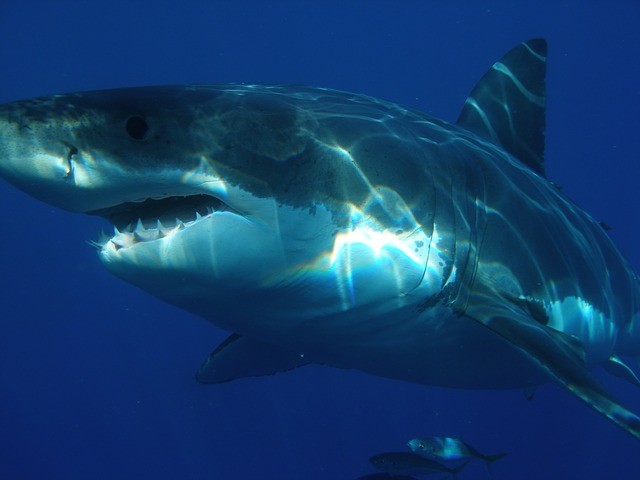
How Big Are Great White Sharks – Great White Shark Size
- The great white shark is a sexually dimorphic species, and the females usually have larger body sizes than males.
- The average body length of adult males measures from 11 to 13 feet (3.4 to 4.0 meters) while that of adult females is from 15 to 16 feet (4.6 to 4.9 meters).
- The largest verified specimen was a female with up to 20 feet (6.1 meters) body length.

How Much Does A Great White Shark Weigh – Great White Shark Weight
- Adult male great white sharks have an average body weight of 522 to 771 kg (1,151 to 1,700 pounds).
- While adult females have an average body weight of 680 to 1,110 kg (1,500 to 2,450 pounds).
- The verified heaviest specimen was a female with up to 2,268 kg (5,000 pounds) body weight.
How Many Teeth Do Great White Sharks Have – Great White Shark Teeth
- Great white sharks have about 300 sharp, triangular, and serrated teeth.
- Their teeth are arranged in many rows (usually 5 and as much as 7) on the upper and lower jaws.
- Great white sharks use the first two rows of their teeth for grabbing and cutting the prey.
- While teeth in the back rows replace the front teeth when they are worn down, broken, or fall.
- A great white shark may have as many as 3,000 teeth at once.
- The front rows have the largest number of teeth.
- When a front tooth is loose, it is replaced by a store of backup teeth embedded in its jaws.

How Long Do Great White Sharks Live – Great White Shark Lifespan
- A 2014 study reveals that the estimated lifespan of great white sharks is as much as 70 years or more.
- It makes great white sharks one of the known longest living species of cartilaginous fish.
- The same study also reveals that a male great white shark takes 26 years to attain sexual maturity while a female becomes able to reproduce at the age of 33 years.
How Fast Is A Great White Shark – Great White Shark Speed
- Great white sharks can swim at the fastest speed of 60 km/h (37 mph) for short bursts.
- They can swim at the depth of 3,900 feet (1,200 meters).
What Makes Great White Sharks Unique
The following are some characteristics that make great white sharks unique:
- Being the largest predatory fish in the world
- Being longest lived cartilaginous fish
- Capable of regulating its body temperature internally
What Do Great White Sharks Eat – Great White Shark Diet
- Great white sharks are carnivores in nature and eat fish, cetaceans, pinnipeds, sea otters, sea turtles, and sea birds.
- They mostly hunt in the early morning time when the visibility is poor. Within 2 hours of sunrise, their success rate of hunting is 55%, which falls in the late morning to only 40%.
- When hunting a seal, a white shark usually ambushes it and then immobilizes it with a quick and sharp massive fatal bite at the hindquarter.
- It then waits for its prey to bleed to death.
- To hunt dolphins and porpoises, a white shark attacks them from behind, above or below to avoid detection by the echolocation of prey.
- To hunt a sea turtle, a white shark bite its carapace around the flipper and so immobilizes the turtle.
- Great white sharks prefer to eat prey with high content of fats that provides high amounts of energy.
- In the South Farallons, a shark expert (Peter Klimley) used a rod-and-reel rig and trolled a sheep’s, pig’s, and seal’s carcasses from his boat. A white shark rejected the sheep’s carcass and attacked the others.
- To remove a chunk of meat, a white shark laterally shakes its head.
- The carcasses of whales are an important part of white sharks’ diet. When feeding on a whale carcass, they first eat fluke and caudal peduncle. They then slowly move around the carcass, mouthing several parts, and then choose the blubber-rich area.
Great White Shark Prey
Great white sharks have a wide range of prey. The following are their major prey species:
- Fish (tuna, rays, and other sharks)
- Whales (pygmy sperm whales, beaked whales)
- Dolphins (dusky dolphin, humpback dolphin, bottlenose dolphin, Risso’s dolphin)
- Porpoises (Dall’s porpoises, harbor porpoises)
- Pinnipeds (seals, sea lions, fur seal, northern elephant seal, Harbor seal, grey seal)
- Sea otters
- Sea turtles
- Sea birds
They also eat the heaviest bony fish, the oceanic sunfish (Mola mola).
Do Great White Sharks Eat Dolphins
- Yes, great white sharks eat dolphins.
- They target the following dolphin species:
- Dusky dolphin (Lagenorhynchus obscurus)
- Bottlenose dolphins (Tursiops species)
- Humpback dolphin (Sousa species)
- Risso’s dolphins (Grampus griseus)
What Sharks Do Great White Sharks Eat
- Great white sharks eat many species of other sharks. Some of them are:
- Whale shark (Rhincodon typus)
- Bull shark (carcharhinus leucas)
- Blue shark (Prionace glauca)
- Basking shark (Cetorhinus maximus)
- Juvenile great white sharks
How Much Does A Great White Shark Eat A Day
- A great white shark can eat several hundred kilograms of food in a single meal.
- The estimated amount of food a great white shark consumes in one year is approximately 11 tons.
- It means a white shark eats an average amount of about 28 kg (62 pounds) of food every day.
- Researchers estimated that a 30 kg whale’s blubber could feed a great white shark of average size (4.5 meters long) for about 1.5 months.
- After a big meal, a great white shark can also go without food for about three months.
How Do Great White Sharks Find Their Food
- Great white sharks find food with their exceptional sense of smell.
- Their sense of smell allows them to detect a single blood drop in ten billion water drops.
- They also have the ampullae of Lorenzini, which is a special electroreceptor sense organ. This allows them to detect the electromagnetic fields emitted by the prey.
- They are extremely sensitive and can detect and locate heartbeats or even immobile prey.
Great White Shark Food Chain
The following is the food chain of great white shark:
-
Source of energy
- Sun is the ultimate source of energy.
-
Producers
- Seaweeds and algae are the producers. It takes energy from the sun and prepares its food through photosynthesis.
-
Primary consumers
- Primary consumers are the animal species that eat producers.
- In this food chain, shrimps and green sea turtles are examples of primary consumers.
-
Secondary consumers
- They are the carnivore animal species that eat shrimps and other crustaceans.
- Fish species and whales are the secondary consumers.
-
Tertiary consumers
- The great white shark is the tertiary consumer.
- It is a top predatory fish and eats about every species of fish and marine mammals.
-
Predators
- Killer whales or Orcas are the only predators of great white sharks.
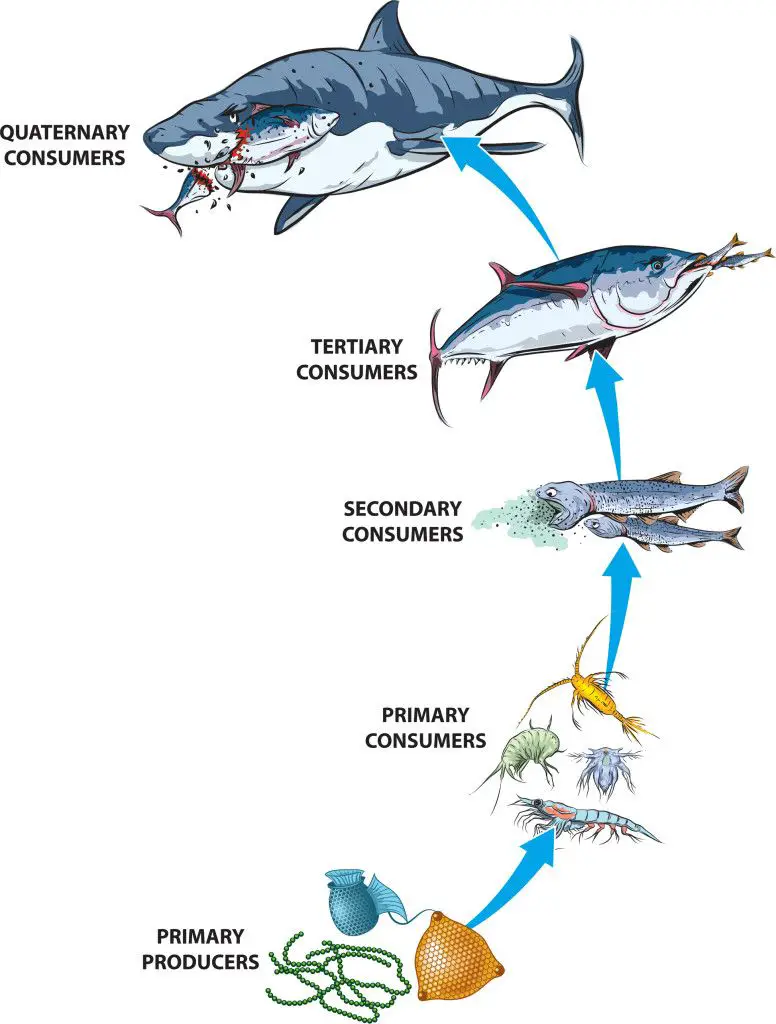
Where Do Great White Sharks Live – Great White Shark Habitat
- Great white sharks are found in the offshore and coastal warm waters of almost all seas with the water temperature range between 12 and 24℃ (54 and 75℉).
- They do not prefer the deep waters of open oceans and make deep dives only occasionally.
- They are found in waters as shallow as 1 meter and at the depth of about 1,280 meters.
- Studies on great white sharks reveal that they spend their daytime at the depth of about 450 meters while coming to the surface at night.
- They are highly concentrated in the United States, South Africa, Chilli, and Oceania.
- In the Eastern Atlantic ocean, great white sharks are found in France, Senegal, Ghana, and the Democratic Republic of Congo.
- In the Western Atlantic ocean, they are found from Newfoundland (Canada) to Florida, Cuba, Bahamas, the Gulf of Mexico, Brazil, Argentina, and Guadeloupe.
- In the Mediterranean, they are found in North Africa, the southern region of France, the western and southern coastal regions of Italy, Croatia, Malta, Greece, and Turkey (in the seas of Marmara and Bosporus).
- In the Indian Ocean, they are found in the Red Sea, Seychelles, and South Africa.
- In the Eastern Pacific, they are found from Panama to Chilli, and in the United States from Alaska to California.
- In the Central Pacific, they are found in Hawaii (USA).
- In the Western Pacific ocean, great white sharks are found in Japan, Korea, China, the Philippines, Australia, and New Zealand.
Great White Shark Habitat Map
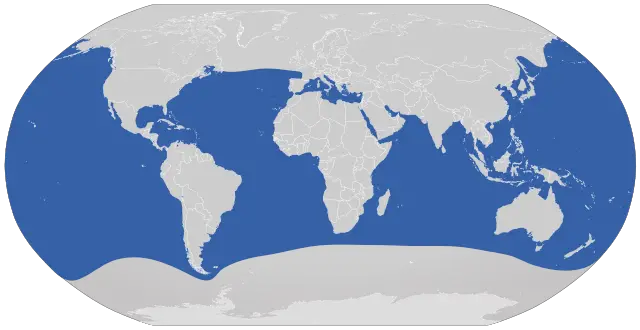
Why Do Great White Sharks Migrate – Great White Sharks Migration
- The great white shark is a highly migratory species.
- The exact reason for their migration is unknown, however, mating or seasonal feeding may be the possible reasons.
- A study reveals that great white sharks migrate from California to a region known as Great White Cafe (located between Baja California and Hawaii), spend at least 100 days there, and then migrate back to California.
- When migrating from California, they slowly swim in their journey and make dives of about 3,000 feet (900 meters). They then change their behavior after their arrival and make short dives of about 980 feet (300 meters).
- In another study, a white shark was tagged off the coast of South Africa that migrated to the southern coast of Australia and returned within the year.
- In a similar study, a great white shark was tracked in South Africa, migrated to the northwestern coast of Australia, and returned. It made a journey of more than 12,000 miles (20,000 km) in nine months.
Great White Shark Life Cycle – Life Cycle Of A Great White Shark
- The life cycle of a great white shark begins when it is born along with its several siblings after a gestation period of 11 months.
- After birth, baby white sharks immediately leave their mother and survive on their own.
- Male great white sharks sexually mature at the age of 26 years while females at the age of up to 33 years.
- The adults then mate and produce offspring.
- The estimated lifespan of a great white shark is 70 years.
How Does The Great White Shark Reproduce – Great White Shark Reproduction
- Great white sharks reproduce in an ovoviviparous mode of reproduction, in which the developing eggs hatch within the uterus, and the embryos continue to develop under the mother’s body until birth.
- After hatching within the uterus, the developing embryos are nourished through oophagy (egg-eating), in which the ovary of the mother produces eggs to feed the developing embryos.
- Their gestation period is 11 months.
- The females give birth to live pups in the form of a group known as litter in spring and summer.
- The recorded largest number of pups a great white shark mother produced was 14.
- The usual number of pups a white shark mother produces is 2 to 10.
Baby Great White Shark
- A baby great white shark is known as a pup and is borns along with his siblings.
- The strong jaws of a pup start to develop with the first month of gestation.
- At birth, it has about 5 feet (1.5 meters) body size.
- As a pup grows, it attains about four times bigger size than that of its birth.
- A pup survives on its own and mothers do not care for it.
- Most of the pups do not survive till their first birthday and are eaten by other predators or adult great white sharks.
- The pups usually eat fish and rays.
- As a pup grows, marine mammals (sea lions and seals) become its favorite prey.
- The estimated age, at which a male great white shark reaches sexual maturity is 26 years while that for a female is 33 years.
How Dangerous Are Great White Sharks – Great White Shark Attack
- Of all species of sharks, the great white shark is responsible for the largest number of recorded unprovoked attacks on humans.
- Every year, more than 100 shark attacks on humans are recorded worldwide, of which great white sharks are responsible for about one-third.
- In films and novels, the great white shark is imaged as a “man-eater”. However, it is not the real case.
- Great white sharks are naturally curious creatures and take a “sample or exploratory bite” before eating unusual prey.
- After sample-biting, they quickly realize that the prey is their favorite or not. When prey is unfavoriting, they release it.
- Humans are not their favorite prey.
- So when they bite humans, they take only a sample bite. But due to their huge size, their sample-bite would be fatal or extremely traumatic for humans.
Great White Shark Behavior
- Great white sharks show complex social structure and behavior.
- In South Africa, they exhibit a dominant hierarchy and the females dominate males, large individuals dominate smalls, and the resident individuals dominate the newcomers.
- They are largely solitary, but some pairs have observed swimming together and associate for a long time.
- Some individuals tend to stay in a feeding area throughout the year while the others are widely migratory.
- Great white sharks are not usually aggressive towards each other. They tend to separate when hunting and solve conflicts with displays and rituals.
- Some individuals have been seen with bite marks that resemble those of other white sharks. It was suggested that the bite marks were of warning bites or one individual showed dominance over another when one white shark closely approached another.
- Great white sharks also show a behavior known as spy-hopping, breaching, or surfacing behavior. They regularly lift their head above the water surface to stare at things such as prey.
- Great white sharks are curious creatures, show intelligence, and socialize according to the situations. At Seal Island, their arrival and departure are observed in the form of stable clans composed of two to six individuals. There is an alpha-leader in every clan while each clan member also has an established rank.
When Do Great White Sharks Sleep
- Great white sharks sleep whenever they are well fed after a big meal and feel secure.
- They sleep with their eyes open as they do not have eyelids.
- During sleep, they slowly swim in an autopiloting manner and keep their mouth open so that water passes through their gills.
- When sleeping, they may rest parts of their brain.
Great White Shark Adaptations
Great White Shark Physical Adaptations – Great White Shark Structural Adaptations
The following are some of the major adaptations of a great white shark:
-
Body shape
- A great white shark has a torpedo-like body shape, which reduces friction when they are swimming.
-
Skin color
- The skin color of a white shark is one of its major adaptations.
- The blue or grey color of the upper body blends with the ocean floor when anyone sees it from above while its white underside blends with reflected sunlight when looked at from the ocean floor.
-
Flexible jaws and serrated teeth
- Great white sharks have muscular and flexible jaws and extremely sharp, quickly replaceable, serrated teeth.
- Their jaws and teeth allow them to easily hunt large prey, sometimes with only a single quick and sharp bite.
- The bite force of an average-sized white shark is estimated as 18,216 newtons.
-
Sharp vision
- Great white sharks have large eyes and sharp vision.
- Their eyes have both rods and cones and can see in bright and dim light, but it is believed that they are primarily daytime hunters.
-
Keen sense of smell
- Great white sharks have a keen sense of smell.
- They can accurately smell a single blood drop in 100 liters of water.
- They can detect a colony of seals through its sense of smell from a distance of two miles.
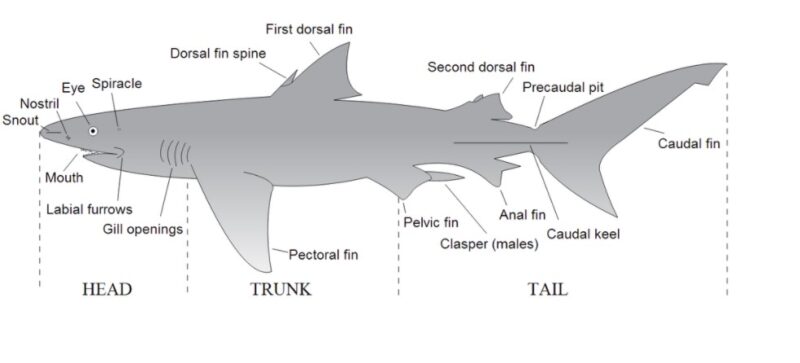
Great White Shark physiological Adaptations
The following are the major physiological adaptations of great white sharks:
-
Ampullae of Lorenzini
- Ampullae of Lorenzini refers to a network of special electroreceptors sensory organs.
- Like other sharks, this extra sense enables a white shark to detect the electromagnetic fields that living organisms emit through movement.
- Great white sharks can detect electric variations of half a billionth of a volt.
- Their extreme sensitivity allows them to detect the heartbeat of immobile animals and locate them everywhere.
-
Web of blood vessels (Rete Mirabile)
- Rete mirabile is a Latin word, which means ‘wonderful net’.
- In great white shark, it refers to a web-like structure of arteries and veins located along each lateral body side.
- It is one of a white shark’s major adaptations that maintains its body temperature warmer than the surrounding temperature of the water.
- This structure conserves heat; warm the cooler blood of arteries with the blood of veins that have been warmed by muscle activity.
- So certain body parts (especially the stomach) are kept at temperatures up to 14°C (25 °F) above the surrounding temperature. While the gills and heart remain at the surrounding water temperature.
- To conserve energy, they drop their core body temperature to match the surrounding.
- So great white sharks are considered mesotherms or endothermic poikilotherms, as they have internally regulated body temperature rather than a constant body temperature.
-
Fat reservoir
- During long migrations, great white sharks use their stored fats and oils in their liver.
- A white sharks’ liver not only controls its buoyancy but is also essential in migrating patterns.
- A white shark that can quickly use its internal energy stores can fastly sink during drift diving than the others.
-
Healthy immune system
- Great white sharks have a healthy immune system.
- Toxicity from heavy metals has no significant effect on their body.
- They are also known to tend to self-healing and avoid age-related illnesses.
What Are The Behavioral Adaptations Of A Great White Shark
Great white sharks have several behavioral adaptations to survive. Some of these adaptations are:
-
Flexible activity patterns
- Unlike other species of shark, great white sharks may be active during the day and night.
- Due to their sharp vision in bright light, scientists suggest that they would be more active during the daytime.
- They are more active during the early morning and have a high rate of hunting success.
-
Hunting strategies
- Great white sharks use different hunting strategies for different species of prey.
- To hunt an elephant seal, a white shark attacks its hindquarter and immobilizes it with a single large bite.
- To attack other seals present at the water surface, a great white shark makes a position beneath the seal. It propels water with its tail and then sprints upward and bursts out of the water in a jump known as a breach captures the seal and falls back into the water.
- To attack dolphins or porpoises, a great white shark avoids being detected by their echolocation and attacks them from behind, below, or above.
- To hunt a sea turtle, a great white shark immobilizes it with a simple bite through the carapace around the flipper.
-
Migratory habits
- Great white sharks are migratory and make long migrations every year.
- They possibly migrate for food and mating.
-
Social hierarchy
-
- Great white sharks exhibit a social and dominant hierarchy.
- Large females dominate males, large individuals dominate the small individuals, and the residents dominate the newcomers.
- At Seal Island, great white sharks are known to arrive and depart in the form of stable groups known as ‘clans’. A clan may have two to six individuals. A clan has an alpha leader while every other member has an established rank. When individuals of a clan meet with another clan, they non-violently establish social ranks through a variety of interactions.
- Adult individuals are also observed feeding together on the same whale carcass and not aggressive towards each other.
How Many Great White Sharks Are Left – Great White Sharks Population
- There is no accurate and reliable data about the worldwide population of great white sharks.
- In 2014, George H. Burgess, Florida Museum of Natural History, University of Florida did a study and estimated the number of great white sharks near the coast of California as 2,000.
- Scientists agree that the population of great white sharks is declining very steeply. That is why it is included in the list of ‘Vulnerable’ species on the IUCN Red List.
Are Great White Sharks Endangered – Why Are Great White Sharks Endangered
- No, great white sharks are not endangered, they are vulnerable.
- Their population is decreasing due to several factors, such as:
- The long period between birth and sexual maturity (about 26 years for males and 33 years for females)
- Hunting for fins, jaws, and teeth
- Catch accidentally in the gill-nets of fishermen
- Targeted as a game fish
Great White Shark Conservation Status
- The conservation status of great white shark species as “Vulnerable” on the IUCN Red List.
What Eats Great White Sharks – Great White Sharks Predator
- Except for orca or killer whales, there are no known natural predators of the great white sharks.
- Killer whales also attack them very rarely.
- The juveniles of great white sharks have many predators including adult great white sharks and other shark species.
- People hunt great white sharks for their jaws, teeth, and fins.
Is Great White Shark Edible
The meat of the great white shark should not be eaten because;
- It has a high level of mercury that is poisonous for humans and can sterilize them.
- It urinates through its highly porous skin. When a white shark dies, the conversion of ammonia to urea does not occur and ammonia remains in their tissues. So the meat of a white shark has an extremely pungent smell.
Great White Shark Interesting Facts
- On our planet earth, the great white shark is the largest living predatory fish.
- When a great white shark’s pup is born, it quickly swims away to be not eaten by its mother.
- A great white shark can take about 14 kg of flesh with a single bite. It can eat several hundred kilograms of food at a time.
- An average-sized great white shark specimen can bite with a force of about 18,216 newtons.
- A mother great white shark does not take care of her pups and only sees them as apery.
- Due to an exceptional sense of smell, a great white shark can smell a single blood drop in 100 liters of water.
- They can detect and locate immobile animals with their heartbeats.
- A study reveals that male great white sharks take 26 years to mature sexually while females become able to reproduce at the age of 33 years.
- Great white sharks keep the ocean clean by eating carrions and dead bodies of whales and other marine animals.
- Great white sharks are the apex predators and exist on the top of the food chain. However, they are under threat due to certain human activities, such as illegal hunting and overfishing. That is why the IUCN Red List included it in the list of Vulnerable species.

